ITECH1102 Networking Security Report: Network Components and Protocols
VerifiedAdded on 2023/06/07
|10
|2186
|122
Report
AI Summary
This report provides a comprehensive overview of networking security, covering various aspects of network connectivity, communication protocols, and cloud computing. It begins with an introduction to computer networking, explaining the role and function of network connectivity, including the use of switches, routers, and gateways. The report then delves into the principles of communication in networks, discussing addressing technologies and the TCP/IP protocols. It explores the roles and functions of hardware and software entities within a network, detailing components such as routers, switches, network interface cards, and various software applications. The report also examines the protocols and interactions that implement network communication, including HTTP and FTP. Furthermore, it covers the fundamental aspects of cloud computing, including Infrastructure as a Service (IaaS), Platform as a Service (PaaS), and Software as a Service (SaaS). Finally, the report concludes by highlighting the impact of network technology improvements on communication and the emergence of technologies like cloud computing, providing a clear understanding of networking security concepts.

NETWORKING SECURITY
Paraphrase This Document
Need a fresh take? Get an instant paraphrase of this document with our AI Paraphraser
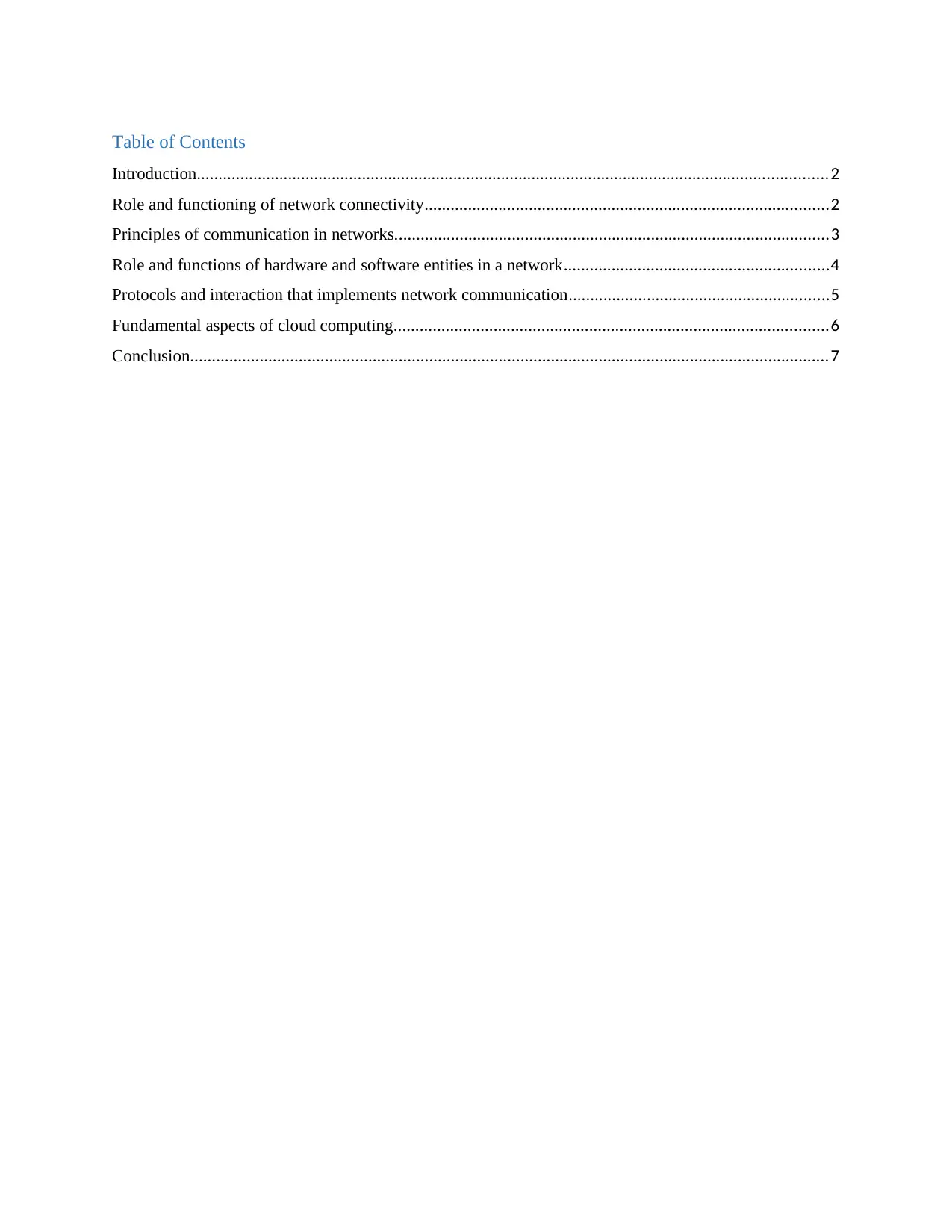
Table of Contents
Introduction.................................................................................................................................................2
Role and functioning of network connectivity.............................................................................................2
Principles of communication in networks....................................................................................................3
Role and functions of hardware and software entities in a network.............................................................4
Protocols and interaction that implements network communication............................................................5
Fundamental aspects of cloud computing....................................................................................................6
Conclusion...................................................................................................................................................7
Introduction.................................................................................................................................................2
Role and functioning of network connectivity.............................................................................................2
Principles of communication in networks....................................................................................................3
Role and functions of hardware and software entities in a network.............................................................4
Protocols and interaction that implements network communication............................................................5
Fundamental aspects of cloud computing....................................................................................................6
Conclusion...................................................................................................................................................7
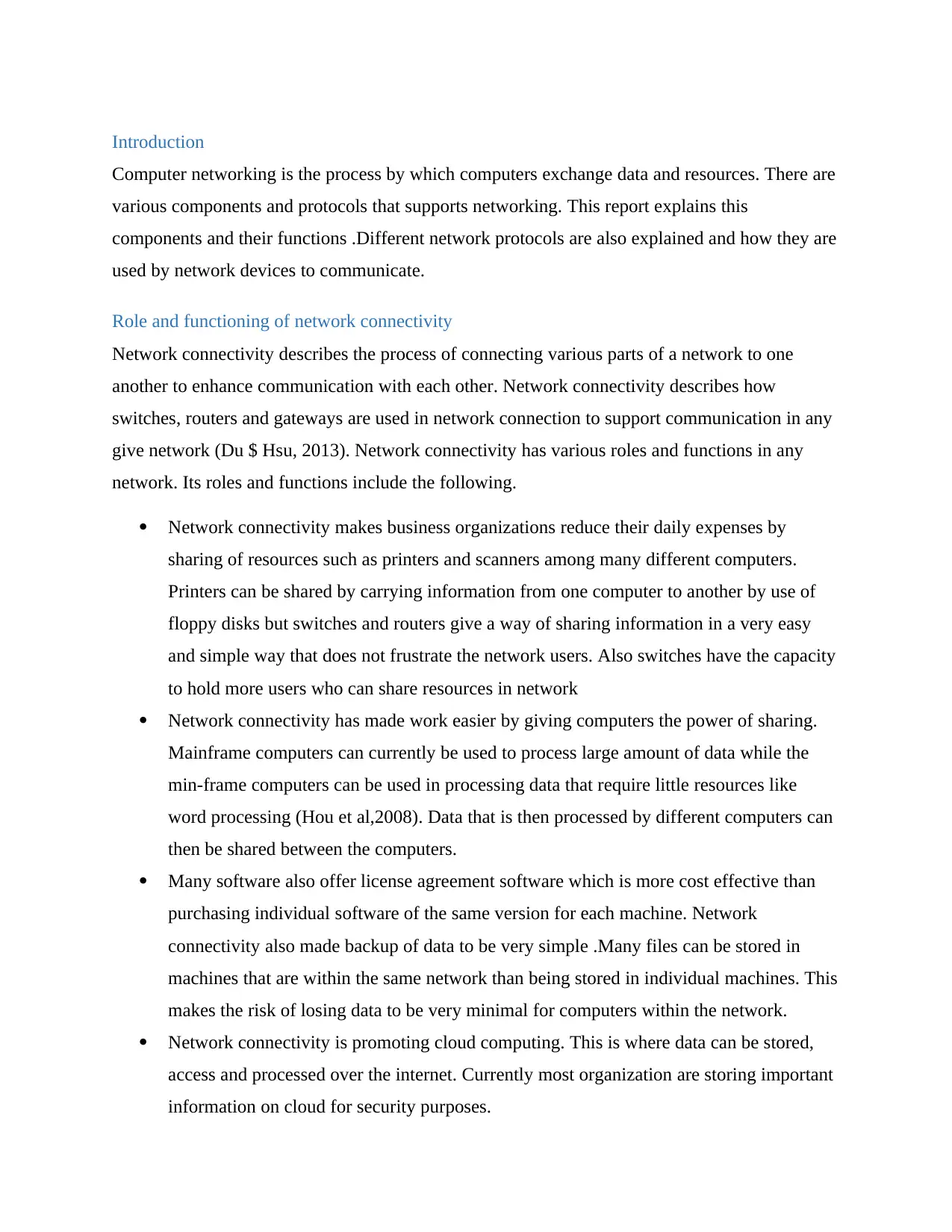
Introduction
Computer networking is the process by which computers exchange data and resources. There are
various components and protocols that supports networking. This report explains this
components and their functions .Different network protocols are also explained and how they are
used by network devices to communicate.
Role and functioning of network connectivity
Network connectivity describes the process of connecting various parts of a network to one
another to enhance communication with each other. Network connectivity describes how
switches, routers and gateways are used in network connection to support communication in any
give network (Du $ Hsu, 2013). Network connectivity has various roles and functions in any
network. Its roles and functions include the following.
Network connectivity makes business organizations reduce their daily expenses by
sharing of resources such as printers and scanners among many different computers.
Printers can be shared by carrying information from one computer to another by use of
floppy disks but switches and routers give a way of sharing information in a very easy
and simple way that does not frustrate the network users. Also switches have the capacity
to hold more users who can share resources in network
Network connectivity has made work easier by giving computers the power of sharing.
Mainframe computers can currently be used to process large amount of data while the
min-frame computers can be used in processing data that require little resources like
word processing (Hou et al,2008). Data that is then processed by different computers can
then be shared between the computers.
Many software also offer license agreement software which is more cost effective than
purchasing individual software of the same version for each machine. Network
connectivity also made backup of data to be very simple .Many files can be stored in
machines that are within the same network than being stored in individual machines. This
makes the risk of losing data to be very minimal for computers within the network.
Network connectivity is promoting cloud computing. This is where data can be stored,
access and processed over the internet. Currently most organization are storing important
information on cloud for security purposes.
Computer networking is the process by which computers exchange data and resources. There are
various components and protocols that supports networking. This report explains this
components and their functions .Different network protocols are also explained and how they are
used by network devices to communicate.
Role and functioning of network connectivity
Network connectivity describes the process of connecting various parts of a network to one
another to enhance communication with each other. Network connectivity describes how
switches, routers and gateways are used in network connection to support communication in any
give network (Du $ Hsu, 2013). Network connectivity has various roles and functions in any
network. Its roles and functions include the following.
Network connectivity makes business organizations reduce their daily expenses by
sharing of resources such as printers and scanners among many different computers.
Printers can be shared by carrying information from one computer to another by use of
floppy disks but switches and routers give a way of sharing information in a very easy
and simple way that does not frustrate the network users. Also switches have the capacity
to hold more users who can share resources in network
Network connectivity has made work easier by giving computers the power of sharing.
Mainframe computers can currently be used to process large amount of data while the
min-frame computers can be used in processing data that require little resources like
word processing (Hou et al,2008). Data that is then processed by different computers can
then be shared between the computers.
Many software also offer license agreement software which is more cost effective than
purchasing individual software of the same version for each machine. Network
connectivity also made backup of data to be very simple .Many files can be stored in
machines that are within the same network than being stored in individual machines. This
makes the risk of losing data to be very minimal for computers within the network.
Network connectivity is promoting cloud computing. This is where data can be stored,
access and processed over the internet. Currently most organization are storing important
information on cloud for security purposes.
⊘ This is a preview!⊘
Do you want full access?
Subscribe today to unlock all pages.

Trusted by 1+ million students worldwide

Principles of communication in networks.
There are various addressing technologies that enable communication of devices within any
given network. They include the following.
For communication to occur in any given network there must be two or more computers
to exchange data in any given network. Without two or more hosts then there will be no
communication.
TCP /IP protocols are used to transfer data from one devices to another within the
network.
There are various addressing technologies that enable communication of devices within any
given network. They include the following.
For communication to occur in any given network there must be two or more computers
to exchange data in any given network. Without two or more hosts then there will be no
communication.
TCP /IP protocols are used to transfer data from one devices to another within the
network.
Paraphrase This Document
Need a fresh take? Get an instant paraphrase of this document with our AI Paraphraser
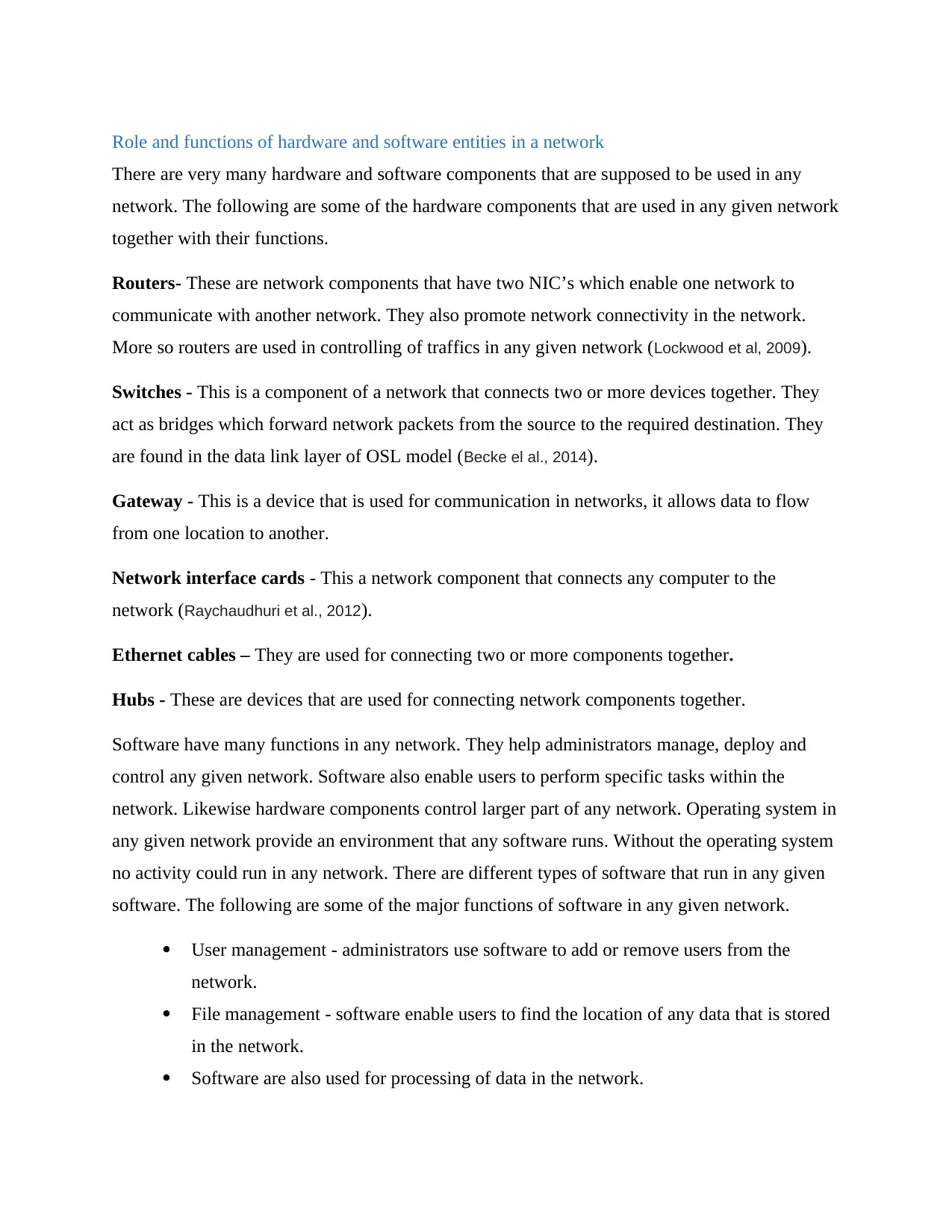
Role and functions of hardware and software entities in a network
There are very many hardware and software components that are supposed to be used in any
network. The following are some of the hardware components that are used in any given network
together with their functions.
Routers- These are network components that have two NIC’s which enable one network to
communicate with another network. They also promote network connectivity in the network.
More so routers are used in controlling of traffics in any given network (Lockwood et al, 2009).
Switches - This is a component of a network that connects two or more devices together. They
act as bridges which forward network packets from the source to the required destination. They
are found in the data link layer of OSL model (Becke el al., 2014).
Gateway - This is a device that is used for communication in networks, it allows data to flow
from one location to another.
Network interface cards - This a network component that connects any computer to the
network (Raychaudhuri et al., 2012).
Ethernet cables – They are used for connecting two or more components together.
Hubs - These are devices that are used for connecting network components together.
Software have many functions in any network. They help administrators manage, deploy and
control any given network. Software also enable users to perform specific tasks within the
network. Likewise hardware components control larger part of any network. Operating system in
any given network provide an environment that any software runs. Without the operating system
no activity could run in any network. There are different types of software that run in any given
software. The following are some of the major functions of software in any given network.
User management - administrators use software to add or remove users from the
network.
File management - software enable users to find the location of any data that is stored
in the network.
Software are also used for processing of data in the network.
There are very many hardware and software components that are supposed to be used in any
network. The following are some of the hardware components that are used in any given network
together with their functions.
Routers- These are network components that have two NIC’s which enable one network to
communicate with another network. They also promote network connectivity in the network.
More so routers are used in controlling of traffics in any given network (Lockwood et al, 2009).
Switches - This is a component of a network that connects two or more devices together. They
act as bridges which forward network packets from the source to the required destination. They
are found in the data link layer of OSL model (Becke el al., 2014).
Gateway - This is a device that is used for communication in networks, it allows data to flow
from one location to another.
Network interface cards - This a network component that connects any computer to the
network (Raychaudhuri et al., 2012).
Ethernet cables – They are used for connecting two or more components together.
Hubs - These are devices that are used for connecting network components together.
Software have many functions in any network. They help administrators manage, deploy and
control any given network. Software also enable users to perform specific tasks within the
network. Likewise hardware components control larger part of any network. Operating system in
any given network provide an environment that any software runs. Without the operating system
no activity could run in any network. There are different types of software that run in any given
software. The following are some of the major functions of software in any given network.
User management - administrators use software to add or remove users from the
network.
File management - software enable users to find the location of any data that is stored
in the network.
Software are also used for processing of data in the network.
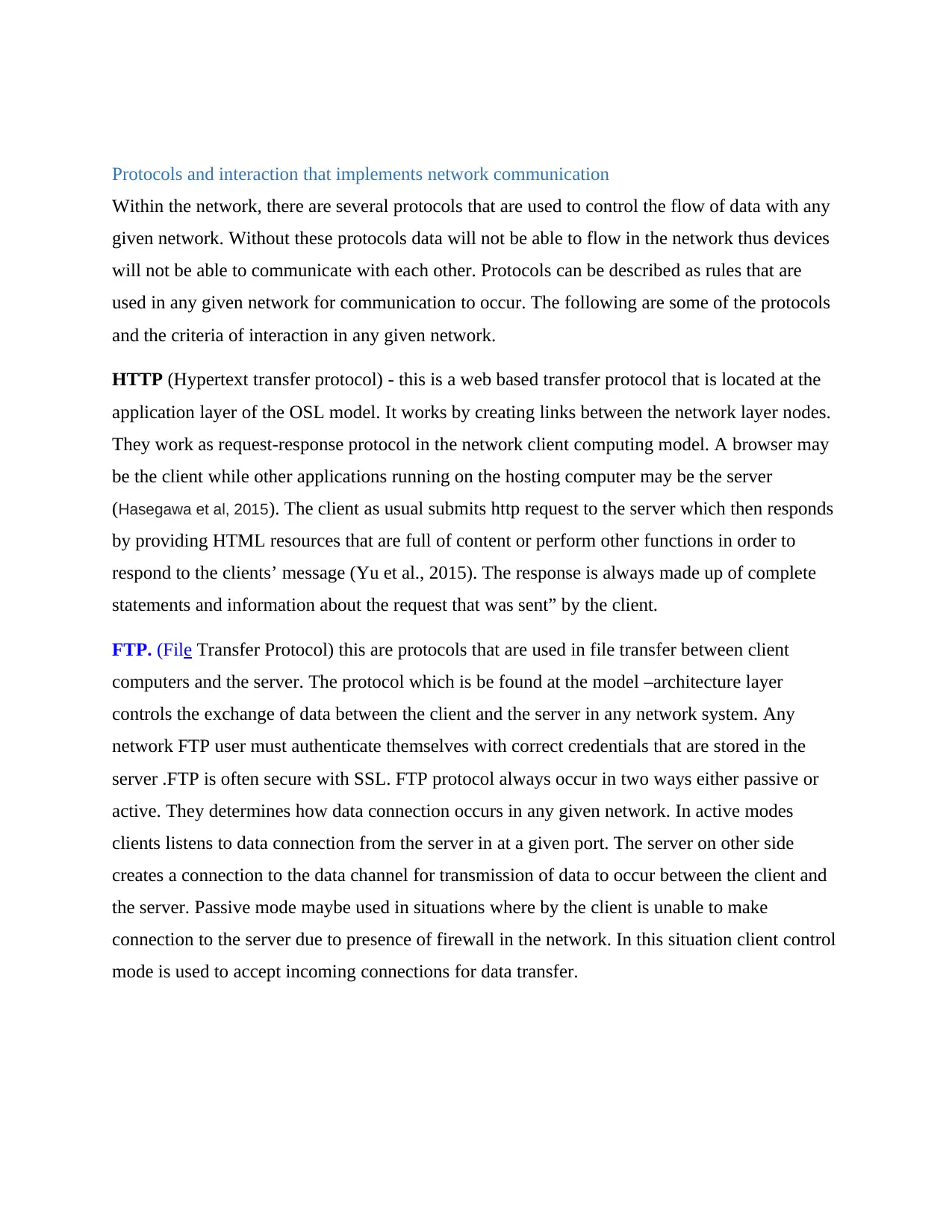
Protocols and interaction that implements network communication
Within the network, there are several protocols that are used to control the flow of data with any
given network. Without these protocols data will not be able to flow in the network thus devices
will not be able to communicate with each other. Protocols can be described as rules that are
used in any given network for communication to occur. The following are some of the protocols
and the criteria of interaction in any given network.
HTTP (Hypertext transfer protocol) - this is a web based transfer protocol that is located at the
application layer of the OSL model. It works by creating links between the network layer nodes.
They work as request-response protocol in the network client computing model. A browser may
be the client while other applications running on the hosting computer may be the server
(Hasegawa et al, 2015). The client as usual submits http request to the server which then responds
by providing HTML resources that are full of content or perform other functions in order to
respond to the clients’ message (Yu et al., 2015). The response is always made up of complete
statements and information about the request that was sent” by the client.
FTP. (File Transfer Protocol) this are protocols that are used in file transfer between client
computers and the server. The protocol which is be found at the model –architecture layer
controls the exchange of data between the client and the server in any network system. Any
network FTP user must authenticate themselves with correct credentials that are stored in the
server .FTP is often secure with SSL. FTP protocol always occur in two ways either passive or
active. They determines how data connection occurs in any given network. In active modes
clients listens to data connection from the server in at a given port. The server on other side
creates a connection to the data channel for transmission of data to occur between the client and
the server. Passive mode maybe used in situations where by the client is unable to make
connection to the server due to presence of firewall in the network. In this situation client control
mode is used to accept incoming connections for data transfer.
Within the network, there are several protocols that are used to control the flow of data with any
given network. Without these protocols data will not be able to flow in the network thus devices
will not be able to communicate with each other. Protocols can be described as rules that are
used in any given network for communication to occur. The following are some of the protocols
and the criteria of interaction in any given network.
HTTP (Hypertext transfer protocol) - this is a web based transfer protocol that is located at the
application layer of the OSL model. It works by creating links between the network layer nodes.
They work as request-response protocol in the network client computing model. A browser may
be the client while other applications running on the hosting computer may be the server
(Hasegawa et al, 2015). The client as usual submits http request to the server which then responds
by providing HTML resources that are full of content or perform other functions in order to
respond to the clients’ message (Yu et al., 2015). The response is always made up of complete
statements and information about the request that was sent” by the client.
FTP. (File Transfer Protocol) this are protocols that are used in file transfer between client
computers and the server. The protocol which is be found at the model –architecture layer
controls the exchange of data between the client and the server in any network system. Any
network FTP user must authenticate themselves with correct credentials that are stored in the
server .FTP is often secure with SSL. FTP protocol always occur in two ways either passive or
active. They determines how data connection occurs in any given network. In active modes
clients listens to data connection from the server in at a given port. The server on other side
creates a connection to the data channel for transmission of data to occur between the client and
the server. Passive mode maybe used in situations where by the client is unable to make
connection to the server due to presence of firewall in the network. In this situation client control
mode is used to accept incoming connections for data transfer.
⊘ This is a preview!⊘
Do you want full access?
Subscribe today to unlock all pages.

Trusted by 1+ million students worldwide
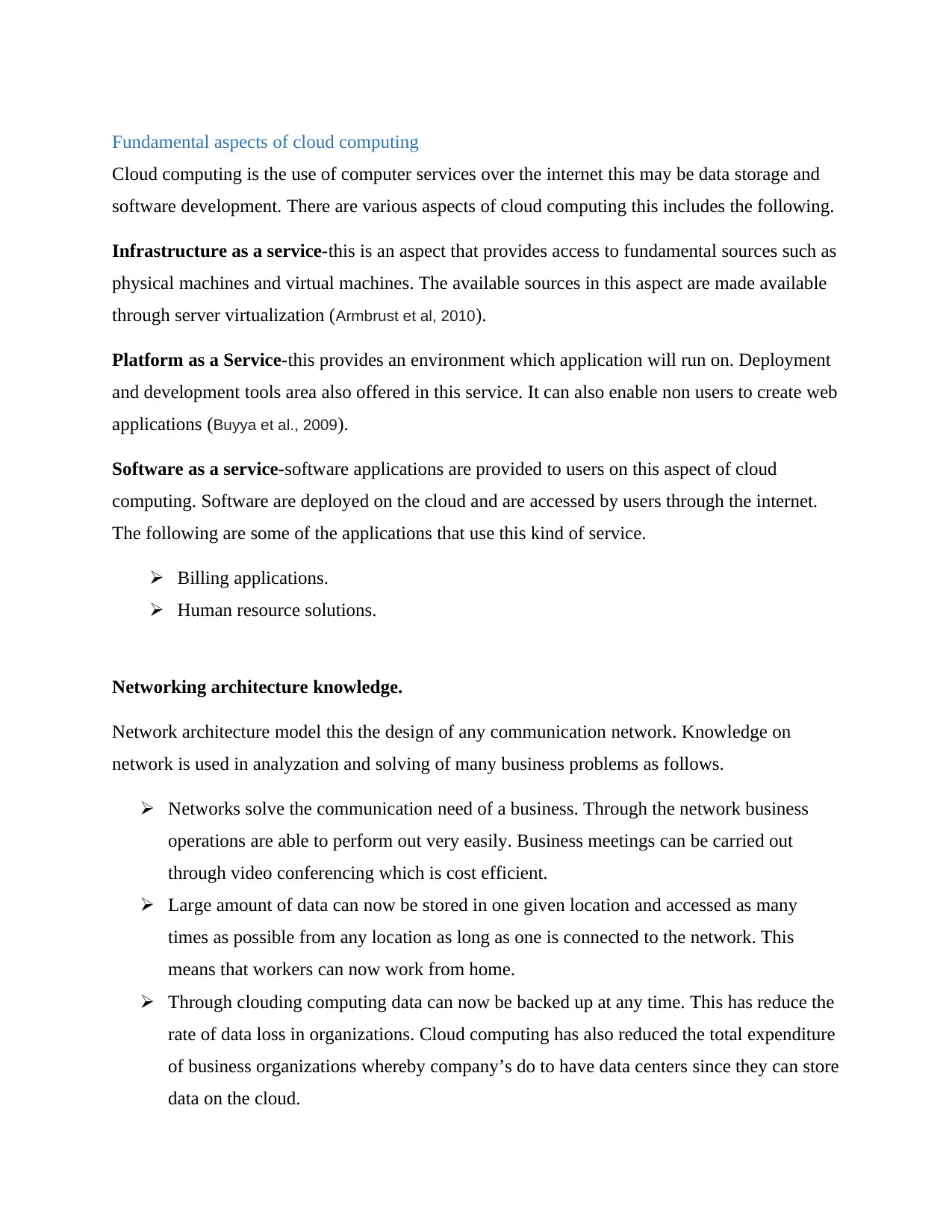
Fundamental aspects of cloud computing
Cloud computing is the use of computer services over the internet this may be data storage and
software development. There are various aspects of cloud computing this includes the following.
Infrastructure as a service-this is an aspect that provides access to fundamental sources such as
physical machines and virtual machines. The available sources in this aspect are made available
through server virtualization (Armbrust et al, 2010).
Platform as a Service-this provides an environment which application will run on. Deployment
and development tools area also offered in this service. It can also enable non users to create web
applications (Buyya et al., 2009).
Software as a service-software applications are provided to users on this aspect of cloud
computing. Software are deployed on the cloud and are accessed by users through the internet.
The following are some of the applications that use this kind of service.
Billing applications.
Human resource solutions.
Networking architecture knowledge.
Network architecture model this the design of any communication network. Knowledge on
network is used in analyzation and solving of many business problems as follows.
Networks solve the communication need of a business. Through the network business
operations are able to perform out very easily. Business meetings can be carried out
through video conferencing which is cost efficient.
Large amount of data can now be stored in one given location and accessed as many
times as possible from any location as long as one is connected to the network. This
means that workers can now work from home.
Through clouding computing data can now be backed up at any time. This has reduce the
rate of data loss in organizations. Cloud computing has also reduced the total expenditure
of business organizations whereby company’s do to have data centers since they can store
data on the cloud.
Cloud computing is the use of computer services over the internet this may be data storage and
software development. There are various aspects of cloud computing this includes the following.
Infrastructure as a service-this is an aspect that provides access to fundamental sources such as
physical machines and virtual machines. The available sources in this aspect are made available
through server virtualization (Armbrust et al, 2010).
Platform as a Service-this provides an environment which application will run on. Deployment
and development tools area also offered in this service. It can also enable non users to create web
applications (Buyya et al., 2009).
Software as a service-software applications are provided to users on this aspect of cloud
computing. Software are deployed on the cloud and are accessed by users through the internet.
The following are some of the applications that use this kind of service.
Billing applications.
Human resource solutions.
Networking architecture knowledge.
Network architecture model this the design of any communication network. Knowledge on
network is used in analyzation and solving of many business problems as follows.
Networks solve the communication need of a business. Through the network business
operations are able to perform out very easily. Business meetings can be carried out
through video conferencing which is cost efficient.
Large amount of data can now be stored in one given location and accessed as many
times as possible from any location as long as one is connected to the network. This
means that workers can now work from home.
Through clouding computing data can now be backed up at any time. This has reduce the
rate of data loss in organizations. Cloud computing has also reduced the total expenditure
of business organizations whereby company’s do to have data centers since they can store
data on the cloud.
Paraphrase This Document
Need a fresh take? Get an instant paraphrase of this document with our AI Paraphraser

Conclusion
The improvement in network technology has increased the rate of communication among
individuals and business organization. Other technologies like clouding computing were
invented from network technology. This has real increased the speed in which data is send from
the source to destination.
The improvement in network technology has increased the rate of communication among
individuals and business organization. Other technologies like clouding computing were
invented from network technology. This has real increased the speed in which data is send from
the source to destination.
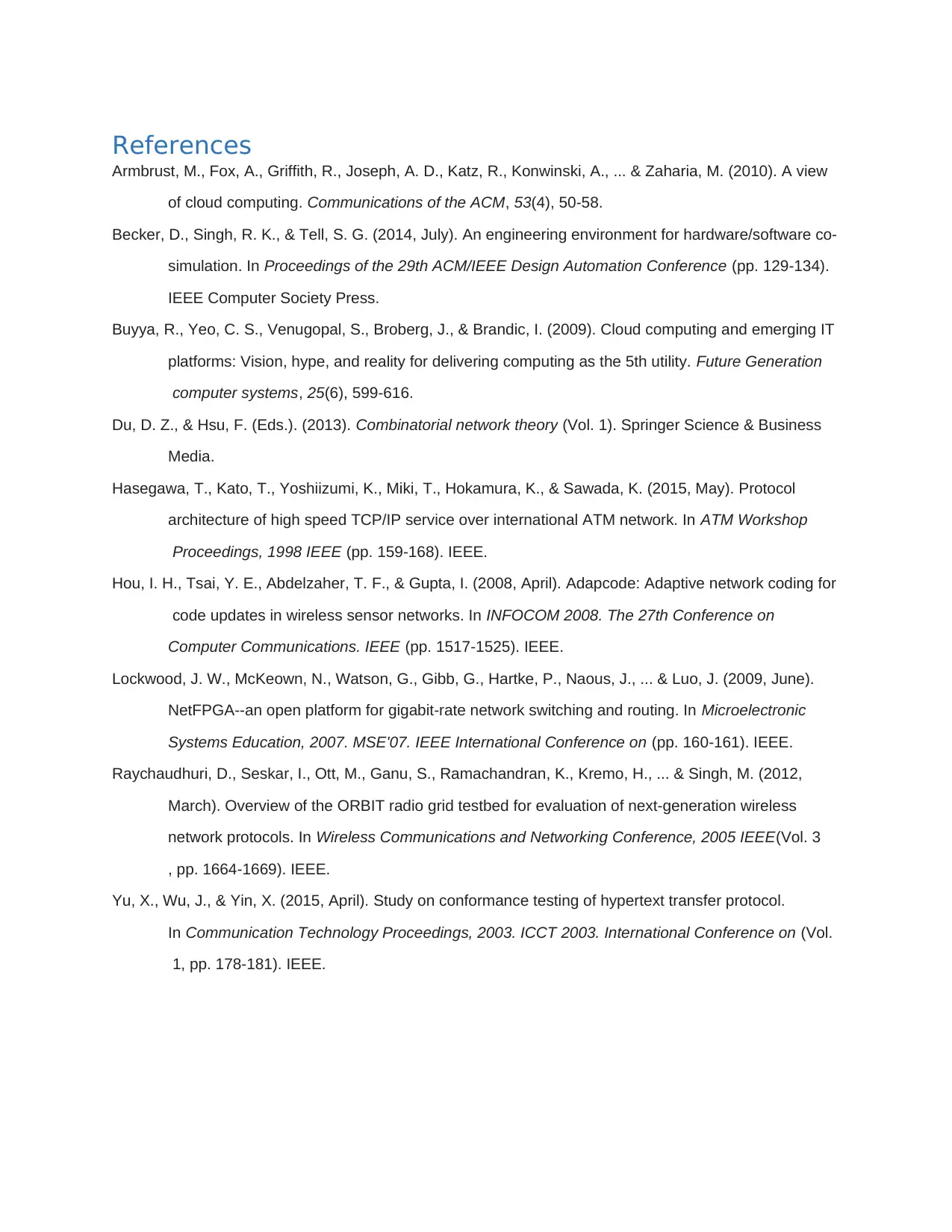
References
Armbrust, M., Fox, A., Griffith, R., Joseph, A. D., Katz, R., Konwinski, A., ... & Zaharia, M. (2010). A view
of cloud computing. Communications of the ACM, 53(4), 50-58.
Becker, D., Singh, R. K., & Tell, S. G. (2014, July). An engineering environment for hardware/software co-
simulation. In Proceedings of the 29th ACM/IEEE Design Automation Conference (pp. 129-134).
IEEE Computer Society Press.
Buyya, R., Yeo, C. S., Venugopal, S., Broberg, J., & Brandic, I. (2009). Cloud computing and emerging IT
platforms: Vision, hype, and reality for delivering computing as the 5th utility. Future Generation
computer systems, 25(6), 599-616.
Du, D. Z., & Hsu, F. (Eds.). (2013). Combinatorial network theory (Vol. 1). Springer Science & Business
Media.
Hasegawa, T., Kato, T., Yoshiizumi, K., Miki, T., Hokamura, K., & Sawada, K. (2015, May). Protocol
architecture of high speed TCP/IP service over international ATM network. In ATM Workshop
Proceedings, 1998 IEEE (pp. 159-168). IEEE.
Hou, I. H., Tsai, Y. E., Abdelzaher, T. F., & Gupta, I. (2008, April). Adapcode: Adaptive network coding for
code updates in wireless sensor networks. In INFOCOM 2008. The 27th Conference on
Computer Communications. IEEE (pp. 1517-1525). IEEE.
Lockwood, J. W., McKeown, N., Watson, G., Gibb, G., Hartke, P., Naous, J., ... & Luo, J. (2009, June).
NetFPGA--an open platform for gigabit-rate network switching and routing. In Microelectronic
Systems Education, 2007. MSE'07. IEEE International Conference on (pp. 160-161). IEEE.
Raychaudhuri, D., Seskar, I., Ott, M., Ganu, S., Ramachandran, K., Kremo, H., ... & Singh, M. (2012,
March). Overview of the ORBIT radio grid testbed for evaluation of next-generation wireless
network protocols. In Wireless Communications and Networking Conference, 2005 IEEE(Vol. 3
, pp. 1664-1669). IEEE.
Yu, X., Wu, J., & Yin, X. (2015, April). Study on conformance testing of hypertext transfer protocol.
In Communication Technology Proceedings, 2003. ICCT 2003. International Conference on (Vol.
1, pp. 178-181). IEEE.
Armbrust, M., Fox, A., Griffith, R., Joseph, A. D., Katz, R., Konwinski, A., ... & Zaharia, M. (2010). A view
of cloud computing. Communications of the ACM, 53(4), 50-58.
Becker, D., Singh, R. K., & Tell, S. G. (2014, July). An engineering environment for hardware/software co-
simulation. In Proceedings of the 29th ACM/IEEE Design Automation Conference (pp. 129-134).
IEEE Computer Society Press.
Buyya, R., Yeo, C. S., Venugopal, S., Broberg, J., & Brandic, I. (2009). Cloud computing and emerging IT
platforms: Vision, hype, and reality for delivering computing as the 5th utility. Future Generation
computer systems, 25(6), 599-616.
Du, D. Z., & Hsu, F. (Eds.). (2013). Combinatorial network theory (Vol. 1). Springer Science & Business
Media.
Hasegawa, T., Kato, T., Yoshiizumi, K., Miki, T., Hokamura, K., & Sawada, K. (2015, May). Protocol
architecture of high speed TCP/IP service over international ATM network. In ATM Workshop
Proceedings, 1998 IEEE (pp. 159-168). IEEE.
Hou, I. H., Tsai, Y. E., Abdelzaher, T. F., & Gupta, I. (2008, April). Adapcode: Adaptive network coding for
code updates in wireless sensor networks. In INFOCOM 2008. The 27th Conference on
Computer Communications. IEEE (pp. 1517-1525). IEEE.
Lockwood, J. W., McKeown, N., Watson, G., Gibb, G., Hartke, P., Naous, J., ... & Luo, J. (2009, June).
NetFPGA--an open platform for gigabit-rate network switching and routing. In Microelectronic
Systems Education, 2007. MSE'07. IEEE International Conference on (pp. 160-161). IEEE.
Raychaudhuri, D., Seskar, I., Ott, M., Ganu, S., Ramachandran, K., Kremo, H., ... & Singh, M. (2012,
March). Overview of the ORBIT radio grid testbed for evaluation of next-generation wireless
network protocols. In Wireless Communications and Networking Conference, 2005 IEEE(Vol. 3
, pp. 1664-1669). IEEE.
Yu, X., Wu, J., & Yin, X. (2015, April). Study on conformance testing of hypertext transfer protocol.
In Communication Technology Proceedings, 2003. ICCT 2003. International Conference on (Vol.
1, pp. 178-181). IEEE.
⊘ This is a preview!⊘
Do you want full access?
Subscribe today to unlock all pages.

Trusted by 1+ million students worldwide

1 out of 10
Related Documents
Your All-in-One AI-Powered Toolkit for Academic Success.
+13062052269
info@desklib.com
Available 24*7 on WhatsApp / Email
![[object Object]](/_next/static/media/star-bottom.7253800d.svg)
Unlock your academic potential
Copyright © 2020–2025 A2Z Services. All Rights Reserved. Developed and managed by ZUCOL.




